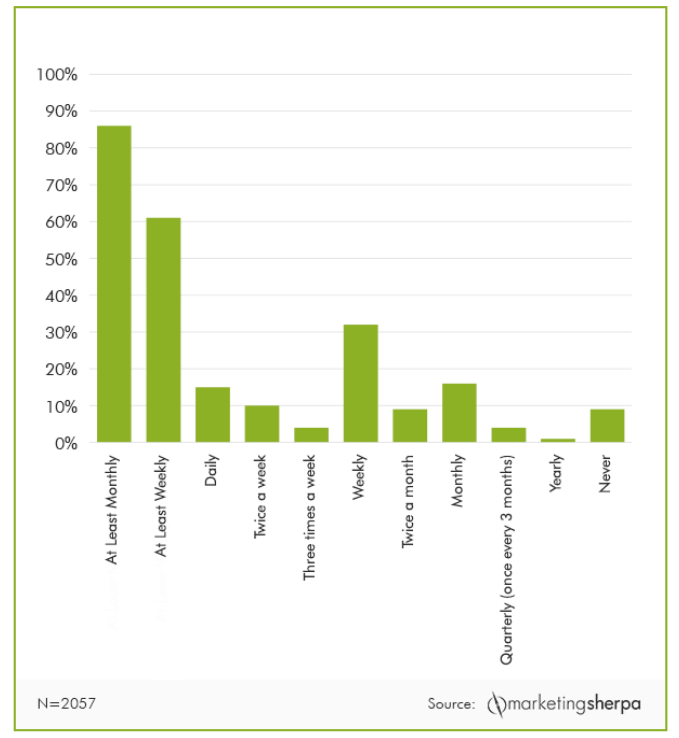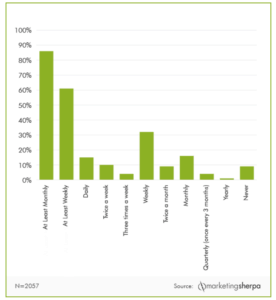
Top 100 Content Marketing Question: How often (frequency) should we be hitting prospects with emails containing content?

Ideal email frequency remains a great marketing mystery
No one has a definitive answer to what the exact email frequency should be.
Here are 3 ideas to help you discover the ideal email frequency for your brand:
- Let subscribers choose the email frequency.
- Test to find out the the right email frequency for your list.
- AI (artificial intelligence) can identify which weeks to avoid sending mega-content emails. Note: next week – the week of March 10, 2019 – is one of the four worst weeks of the year to send a big content email!
Let subscribers choose
When people sign up for your email, offer them a choice of frequencies:
- Daily
- Weekly
- Monthly
Then, deliver exactly what you promised.
That’s the best way to find your ideal frequency since the ideal email frequency varies by buyer, industry, and product or service.
What a survey of 2,000 U.S. adults found
Marketing Sherpa did a survey on ideal email frequency. They asked, “How often, if ever, would you like to receive promotional emails (e.g., coupons, sales notifications) from companies that you do business with?”
More than 2,000 U.S. adults responded to the survey. The good news: more than 9 out of 10 people (91%) want promotional emails from companies they do business with.
Yet respondents’ answers about this varied widely:
- 86% want emails “at least monthly.”
- More than 60% want emails “at least weekly.”
- More than 30% want emails “weekly.”
- 15% want emails “daily.”
- Almost 10% want emails “never.”

Even within a given category, different buyers have different ideas about the ideal email frequency. That’s why it’s best to let everyone choose their own ideal email frequency.
If you don’t know people’s ideal email frequencies, ask the people on your list how often they want to receive emails. It’s better to reduce the email frequency now than to generate a bunch of unsubscribes over time.
Test to find out
Another approach: segment your list to test various email frequencies.
At a minimum, test weekly and monthly frequencies to see which delivers the most opens, click-throughs, conversions, and sales.
Find out the best weeks to send and the weeks to avoid
Christopher S. Penn, an expert who applies artificial intelligence to marketing, used AI to determine the best and worst weeks of the year to send a mega-content email.

One finding: next week is one of the worst weeks of the year to send out your mega-content email!
This advice is based on Chris’ Google searches for how to set up an out-of-office message. The best weeks to send your mega-content email in 2019 are:
- Q2 2019: the week of April 21
- Q3 2019: the week of September 15
- Q4 2019: the week of October 21.
The worst weeks to send your mega-content emails are:
- Q1 2019: the week of March 10
- Q2 2019: the week of June 23
- Q3 2019: the week of July 28
- Q4 2019: the week of December 23.

This forecast is based on Chris’ analysis of web searches for “Outlook out of office.”
“How often (frequency) should we be hitting prospects with emails containing content?” is one of marketers’ Top 100 Questions about #contentmarketing. Here are the answers.






